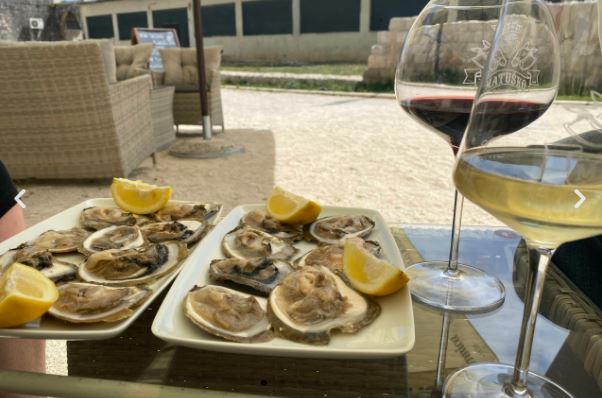Pelješac Bridge Open, But What About Ston Bypass and Access Roads?
July 27, 2022 - The Pelješac Bridge is open, but what about the Ston bypass and other access roads?
A famous proverb says, "Donkeys will not cross the bridge," but Joško Antunović's donkeys from Kuna Pelješka will cross the Pelješac Bridge. They will go to competitions and exhibitions throughout Croatia after many years since driving cattle through the Neum corridor was forbidden. Thus, donkey trips became less frequent and were made exclusively by the Ploče-Trpanj ferry.
"We can hardly wait for this bridge; they will certainly cross it," Antunović told Jutarnji List and added: "This is the last round of hay I will drive on the Ploče-Trpanj ferry. Unfortunately, hay cannot be transported via Neum; the paperwork is complicated, so we go by ferry, but it is too expensive."
Joško Antunović and many other residents in the area are thrilled about the Pelješac Bridge, and they will be even happier when the Ston bypass and the Ston bridge are completed. Those ten kilometers will complete the road connection project in southern Croatia.
The Pelješac Bridge stole the glory from the access roads, bridges, viaducts, and tunnels on which no less significant construction works with three bridges, two viaducts, and four tunnels were carried out and are still ongoing. In addition, two viewpoints and crossings for agricultural machines for the local population were also built. Twenty-five kilometers of access roads have been completed, and another smaller section of 7.5 kilometers from Prapratno to Ston, the so-called Ston bypass, built by the Greek company Avax, remains unfinished. On the other hand, the section constructed by Strabag is nearing completion.
The endlessly long public procurement procedure, bureaucratic entanglements, and numerous appeals slowed down the access road project.
"In addition, the Brijesta junction has been completed, which includes a viaduct of some two hundred meters, where the connecting road descends to the local road in Brijesta," engineer Davor Perić explained.
On the mainland, Strabag built an underpass at the Duboka junction and an underpass on the D8, and on the peninsula, among other things, the Kamenice Tunnel, the Doli Viaduct, the Dumanja Jaruga Bridge 1, the Dumanja Jaruga Bridge 2, the Debeli Brijeg Tunnel, and the Zaradeže underpass.
According to the contract, Strabag Hrvatska is in charge of a route with a total length of more than ten kilometers, of which 1,300 meters on the mainland and 9,220 meters on Pelješac, the value of which is HRK 478.3 million.
The longest among the tunnels is the 2.4 km Debeli Brijek, which first broke ground in December 2020. However, while Strabag was successfully working on its sections, Avax ran into problems on the Ston bypass. First, there was a problem with bringing machinery and equipment from Greece, then the pandemic and labor shortage came, and then financial problems at Avax followed. So the construction of the "Prapratno" viaduct, the "Polakovica" tunnel, the "Supava" tunnel, and the "Ston" bridge, with a total value of HRK 511 million, was delayed. Still, they should be finished by the end of this calendar year.
Avax was also affected by the escalation of material prices, especially concrete and steel, which made adjusting the already agreed prices necessary. According to information from Croatian Roads, there will be no price corrections on the Pelješac Bridge because the material was purchased before inflation and disturbances in the world markets, and modifications could occur for access roads. However, such an increase should not exceed 10 to 15 percent of the currently contracted price of the works.
Until the Ston bypass is completed, heavy trucks and trucks transporting dangerous goods will not be able to travel over the Pelješac Bridge so as not to congest Ston and possibly endanger the environment. They will continue to operate the old way via Neum.
The maximum permitted driving speed on the Pelješac Bridge will be 90 kilometers per hour, which, as on the access roads, will be regulated by dynamic traffic signals, which will be managed from Zaradeže.
The Pelješac Bridge, with part of the access roads, shortens the journey from Zagreb to Dubrovnik by two hours. Kilometer-long queues and hours-long waits at the Klek and Bistrina border crossings are no more.
For more, make sure to check out our dedicated travel section.
Pelješac Bridge Opening Confirmed for End of July
May 27, 2022 - Minister of the Sea, Transport, and Infrastructure Oleg Butković has confirmed that the Pelješac bridge opening will be at the end of July.
Most of the works on the access roads to the Pelješac Bridge are nearing completion. Minister Oleg Butković visited the bridge to confirm that everything was ready for the July opening, reports Dalmacija Danas.
Works on access roads are in full swing. However, everything will depend on July 13, when the technical inspection of access roads and connections with the bridge is scheduled. Then it will be known whether the access roads and the Pelješac bridge have a use permit. In that case, the bridge's grand opening would be in late July. The most distinguished guests from Croatia and the EU are expected at the opening.
Currently, the largest works are on access roads, more precisely at the Brijesta junction. New forces are constantly being brought in to finish everything on time. One of the major problems that emerged during the construction of access roads is the rage in prices on the global market, which has led to an increase in the cost of road connections in Croatia. It is estimated that there was a difference in costs of 100 to 150 million kuna.
Ministar @OlegButkovic: Izvođači rade u zaista otežanim okolnostima zbog globalnih poremećaja na tržištu, ali ništa neće biti dovedeno u pitanje - Pelješki most otvaramo za promet krajem srpnja! pic.twitter.com/c0nQKwieC2
— Vlada Republike Hrvatske (@VladaRH) May 27, 2022
"The bridge is finished; as far as access roads are concerned, we can say that at the end of July, we will open the Pelješac Bridge with part of the access roads, more precisely the second and third phases. The second phase goes from Duboka to Sparagović and the third phase from Sparagović to Prapratno. A total of 25 kilometers of roads. We still have eight kilometers of the Ston bypass and the connection to the state road D8, which should be completed by the end of the year," said Oleg Butković, Minister of the Sea, Transport, and Infrastructure.
"The contractors are working in challenging circumstances due to global market disturbances, but nothing will be called into question," the Minister said.
For more, make sure to check out our dedicated lifestyle section.
Croatia Through the Eyes of a Digital Nomad: A Feast and a Festival with Oysters & Wine
March 25, 2022 - The Feast of St. Joseph meets the Festival of Oysters on Pelješac for a fun day of food, wine, and Dalmatian music.
Two years ago this month I arrived in Split, with a mission to visit to the Ston oyster festival and the town’s famous walls on top of my list. Foodies know the tradition that you should only eat wild oysters during the months that contain the letter "r" in the name – from September to April – and this time of year is peak season for fresh oysters. Even the ancient Romans who inhabited these parts followed this opinion to get their favorite aphrodisiac.
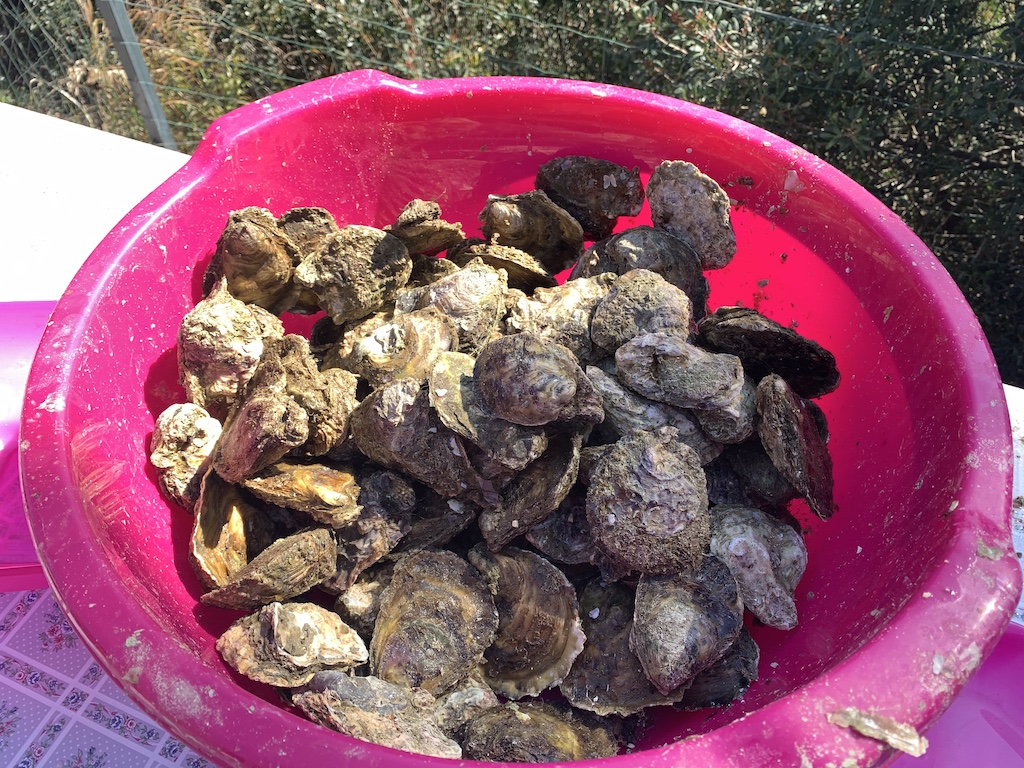 The local oysters found in Mali Ston are called European Oysters, or Ostrea Edulis.
The local oysters found in Mali Ston are called European Oysters, or Ostrea Edulis.
The festival returns
But alas, covid-19 cancelled the festival two years ago and my plans have been on hold, until now. A trip to Bistrina for the annual oyster festival in Mali Ston was a chance to both taste the shellfish this area is famous for and wash it down with vino that puts the Pelješac peninsula on any wine-lover’s radar. The funny thing is, I grew up on the Atlantic Ocean and I adore all seafood, except oysters. I was willing to give them a try in Croatia based on the reputation, but I was hoping there would be more.
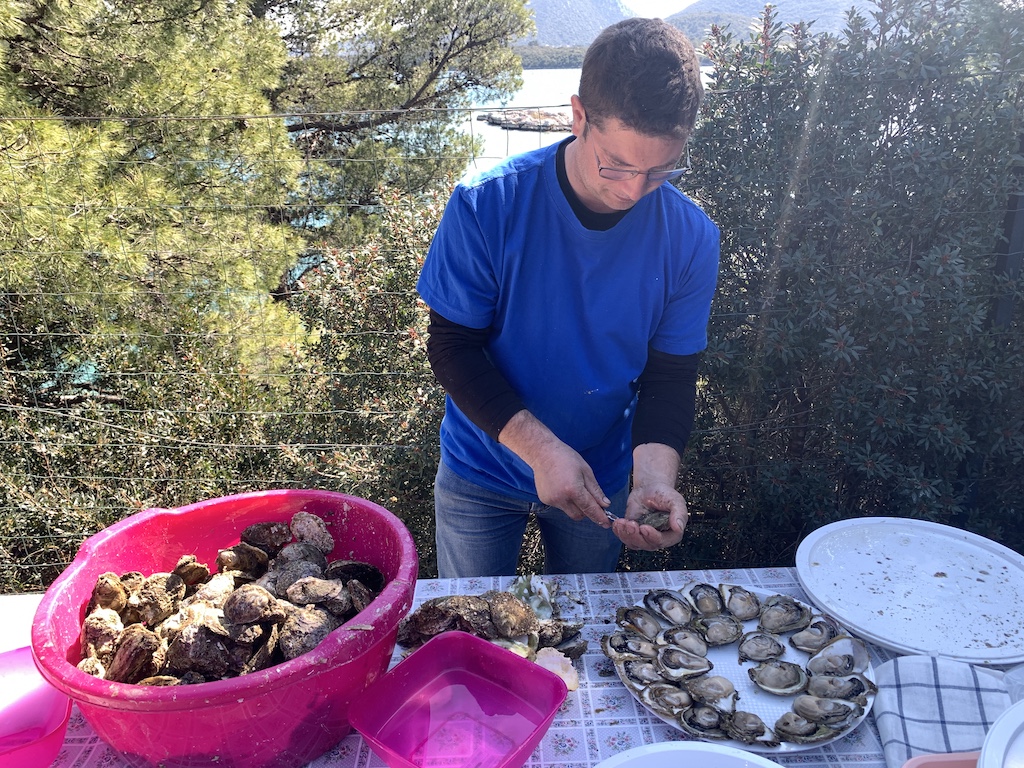 Farming and harvesting oysters in Mali Ston dates back to the Roman days of the Republic of Ragusa (1358-1808) and was a source of wealth that exceeded salt.
Farming and harvesting oysters in Mali Ston dates back to the Roman days of the Republic of Ragusa (1358-1808) and was a source of wealth that exceeded salt.
I joked with a friend that my favorite part of the festival was carrying my wine glass around on my neck, which was a first for me. It looked ridiculous but it was convenient for hands-free slurping of oysters and also more wine, lol. When it came to tasting, the best food tip I received all day was to simply squeeze lemon on the oysters and then suck them off the shell. I can’t say I tasted anything, except for the lemon juice, but it was fun.
Father’s Day
Not accidentally, the festival coincides with the Feast of St. Joseph every March 19, also called Saint Joseph’s Day. It has to do with the Feast falling during lent and abstinence from meat. This is Father’s Day in Croatia and named after Jesus’s dad. Christian heritage here believes he’s the patron saint of Croatian people and a protector of families and carpenters/workers.
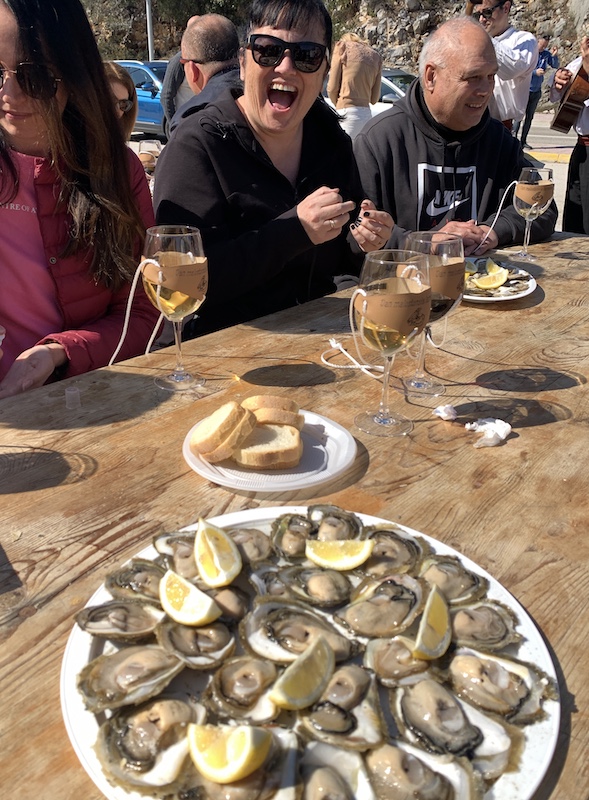 Chowing down with fellow Cromads.
Chowing down with fellow Cromads.
Cultivation techniques
Walking around Bistrina, I noticed clusters of plastic markers throughout the bay. Farmers use a system with cages and a technique of suspending oysters in the water to help them grow. To indicate how seriously people take this business, a nearby mariculture laboratory—part of the University of Dubrovnik—conducts research, testing, and quality checks on the oysters and the mussels from these beds.
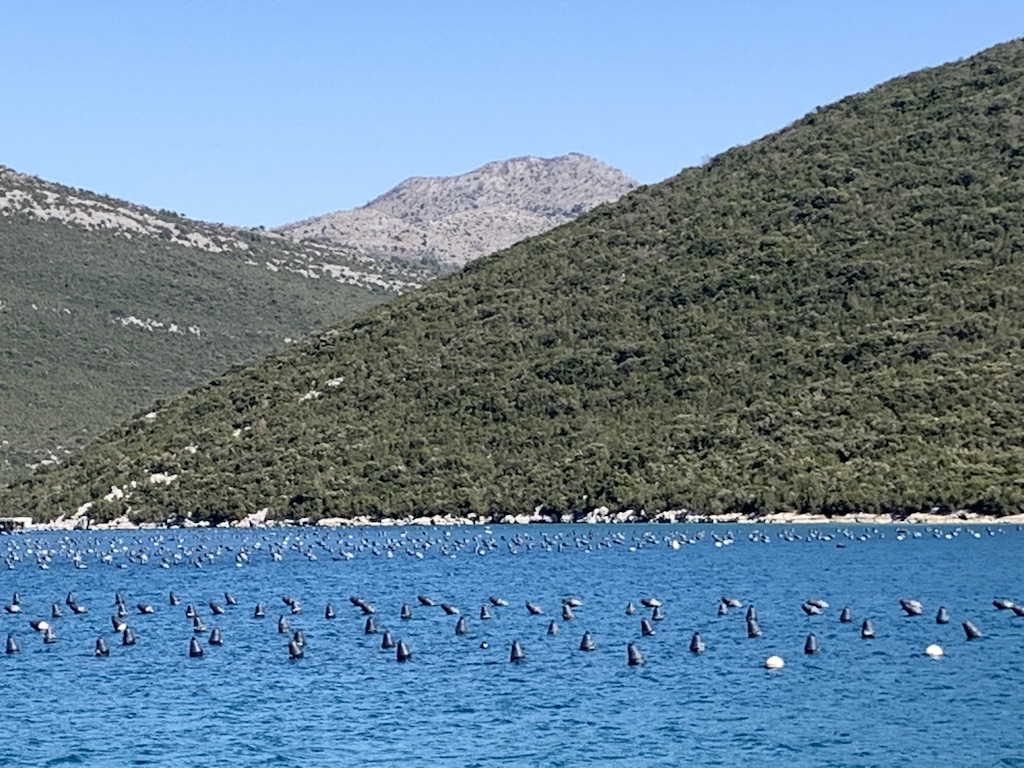 Plastic markers in the bay indicate where the oyster beds are. Minerals and phytoplankton in the salty water contribute to the high-quality of the shellfish.
Plastic markers in the bay indicate where the oyster beds are. Minerals and phytoplankton in the salty water contribute to the high-quality of the shellfish.
Cultivation dates back to the 14th century and peaked in the 1980s with 3,000 tons of mussels and two million oysters produced annually.
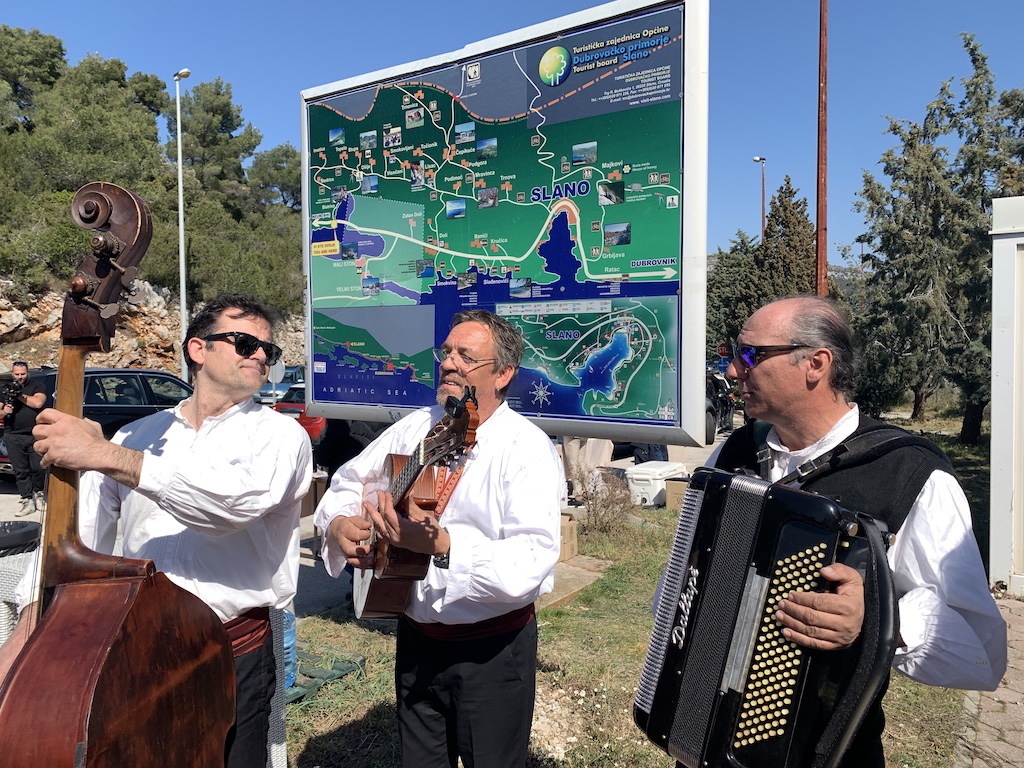 Local musicians play favorite Dalmatian tunes.
Local musicians play favorite Dalmatian tunes.
Natural sea salt, high-quality freshwater, and favorable environmental conditions are the secret sauce for producing exceptional shellfish in this area, and the corresponding wealth. Rumor has it that Roman aristocrats from the days of the Ragusan Republic were even paid in oysters instead of money. So, would they eat their money??
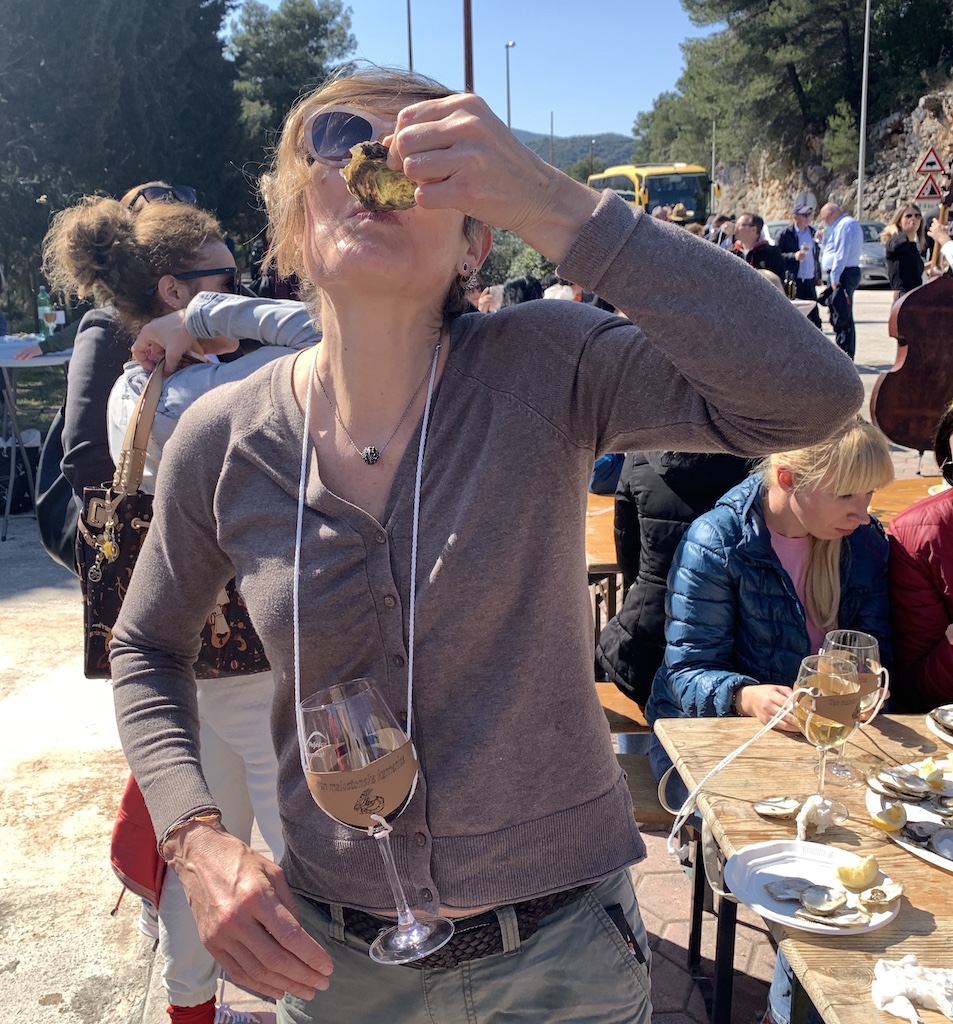 The author keeps her wine glass close to sip and slurp.
The author keeps her wine glass close to sip and slurp.
Ston saltworks
A different system exists over at Ston with an equally impressive history: the saltworks. Salt pans look like a grid dividing the surface of the water. Traditional production methods to extract salt using the sun and wind have remained the same for centuries and everything is still done by hand. Again, healthy environmental conditions are perfect for creating a superior product.
 Salt has been a source of wealth in Ston for centuries, also since the Republic of Ragusa ran things here. These saltworks are the largest in Europe.
Salt has been a source of wealth in Ston for centuries, also since the Republic of Ragusa ran things here. These saltworks are the largest in Europe.
As with the shellfish, Ston’s “white gold” dates back to the Middle Ages as a white-hot commodity. In fact, salt sparked wars and influenced trade routes. Wowza!
Rich history
The day turned out to be much more than hitting up a festival. Ston and Mali Ston have a rich history of tradition, labor, and economics in shellfish and salt, and there’s the famous Pelješac wine. The walls of Ston are another highlight as one of the largest preserved fortification systems in the world, but that’s another story. And let’s not forget the Feast and Father’s Day.
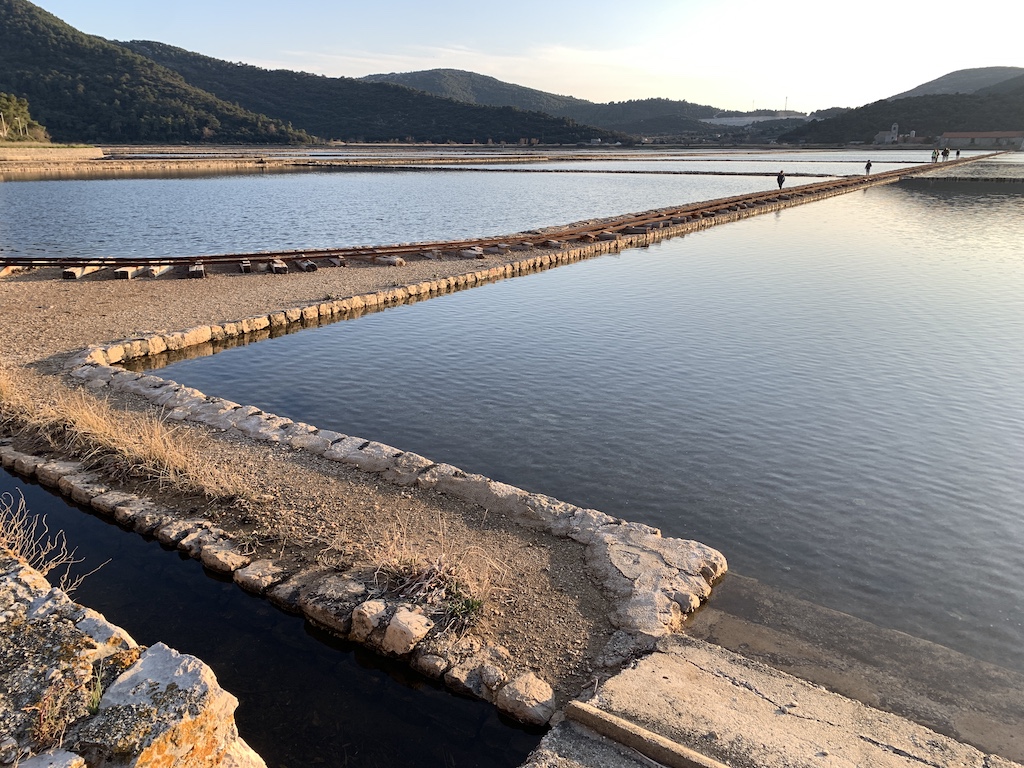 Gates are opened to let water flood into the salt pans. When the water evaporates, the salt is left behind. This process is repeated over and over and the salt is harvested once a year.
Gates are opened to let water flood into the salt pans. When the water evaporates, the salt is left behind. This process is repeated over and over and the salt is harvested once a year.
I love piecing together the cultural connections in this region. It’s one of the reasons I love to travel, for authentic experiences and learning about places that are so different from my home. As a bonus, I got to spend the day with adventurous new friends and digital nomads. The trip was organized by the Cromads travel club.
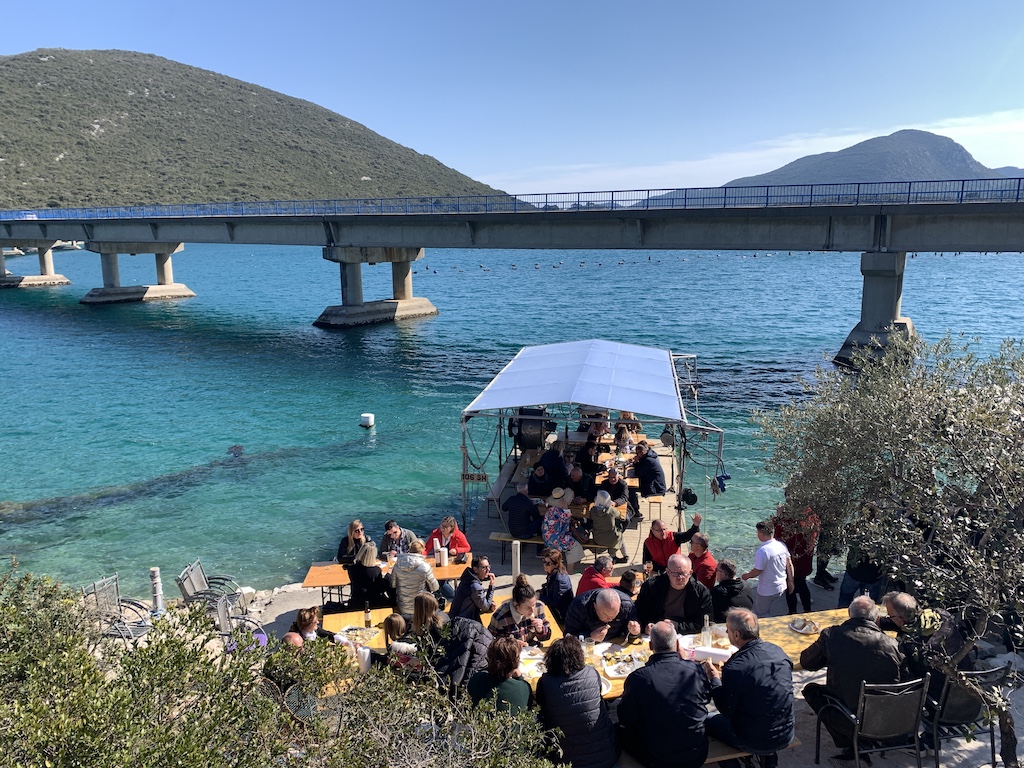 Dining on the Bistrina Bay with a beautiful view of the clear blue water.
Dining on the Bistrina Bay with a beautiful view of the clear blue water.
Story and photographs ©2022, Cyndie Burkhardt. https://photo-diaries.com
Learn more at TCN’s Digital Nomads channel.
Visit the Ston Oyster Festival from Split with the CROMADS Travel Club
March 14, 2022 - What if some of Croatia's best and most authentic experiences were made more accessible? Join the CROMADS Travel Club at this year's Ston Oyster Festival.
Croatia is a unique place in many ways. But one of the things I have come to appreciate over the years is just how many incredible (and incredibly local) things there are to do in this country, many of which are hardly known outside the local area.
We would like to change that, and to make the very best of those experiences more available to expats, digital nomads, and yes, locals too.
Having been an expat in many countries, I know how easy it is to get sucked into the expat way of life, surrounded by other expats and experiencing little of the county around. The CROMADS Travel Club aims to address that issue, if only a little.
Hand-picked events showcasing the best of Authentic Croatia, often experiences that even locals do not know too much about. Take a look at the first CROMADS Travel Club to Velika Gorica, for a truly GINcredible opening event.
Next up, the amazing world of Ston and Mali Ston, and its fabulous oysters. Join the CROMADS Travel Club on a fabulous day at the Ston Oyster Festival, departing from Split.
Immerse yourself in the world of oysters
What: Festival of Oysters
When: 19 March 2022
Where: Ston & Mali Ston, located on the Pelješac peninsula in southern Croatia.
Celebrating the return of the popular Oyster Festival after a two-year break.
Every year March is looked forward to by many as the time for the freshest and tastiest oysters to be enjoyed straight from the sea. Wine, salt and oysters, you can sample all three at the Festival of Oysters.
While traditionally held in Mali Ston, this year the festival will take place at three different locations, Brijesta, Luka and Bistrina. Three locations where oysters are actually grown. At each location visitors have the chance to taste oysters, muscles and other shellfish together with top quality wines from the Pelješac region at promotional prices.
Exclusive Experience
We will start our tour from Split and drive to the Ston area where we will stop off at one of the promoted oyster tasting locations. Here as a group we will indulge ourselves with an oyster tasting while enjoying local wine and live music.
There will also be free time for you to simply sit back and take in the atmosphere of the festival or enjoy a pleasurable lunch at one of the local restaurants making the most of local dishes at promo prices.
From here we travel a short distance to Ston, for all to enjoy a short stop to explore the village and learn about its local traditions and history. Then on to capture the quaintness of Mali Ston before beginning our drive back to Split. These two short stops will have you wanting more as you will learn why a longer visit to Ston is a must on your future itinerary.
Indulge
2022 looks like being a bumper year for oysters, an amazing time for you to immerse yourself in the world of oysters, the freshest and tastiest oysters in Europe. We can’t wait to have you join us!
For more information and to book, check out the CROMADS event page.
Ston Cable Car Planned on Podzvizd Hill with EU Funds
December 28, 2021 - Is a Ston cable car in the cards to bring more visitors to the destination in the coming years? A closer look.
The 2020 budget was adopted at the Ston Municipal Council session. As a result, many projects are being prepared for the new programming period, financed from European Union funds, reports Slobodna Dalmacija.
One is the funicular, or cable car, to Podzvizd hill. The project would give Ston one of Dubrovnik's most popular tourist attractions, which earns a lot of money every year.
Local mayor Vedran Antunica (HDZ) spoke about the state of the cable car project.
"When the Podzvizd Fortress is being renovated, which has a breathtaking view, it would be good to bring it closer to our guests. However, if you have something beautiful, and it is not available to a larger number of people, then there is nothing of it," said the mayor and added:
"Recording a report on the ascent to the walls of Ston, our famous alpinist Stipe Božić once said that he had not experienced such an unforgettable view from Podzvizd, except for Ston, to the south and north side of Pelješac. His statement gave rise to the idea of our funicular.
The first condition for this project is to amend the municipal spatial plan, which should be harmonized with the county. A public debate is underway.
It is a process, from idea to realization. It takes a little more time because it is necessary to make an environmental impact study and conceptual design in addition to economic analysis.
For the reconstruction of the Podzvizd fortress, which is being done by the Society of Friends of Dubrovnik Antiquities, an archeological study and part of the project documentation have been prepared," Antunica emphasizes.
"In the spatial plan, we have defined the area, and whether it will be a cable car or a funicular on rails similar to Zagreb, we will see. The experts will decide that.
And the conservatives approved the idea in principle. One of the ideas is that the starting station should be towards Hodilj, and the descent above Mali Ston, so as not to disturb the views of Ston," said the Municipality leader.
Antunica replied that it is difficult to predict when this will come to fruition.
"We will try to apply for European funds for the project because it is a huge amount of money," the mayor said and added that other councilors have accepted this idea as good:
"This project will improve the whole area, not only to the Municipality of Ston. Who could be against that? It will also bring new jobs. If it is half as successful as Dubrovnik, it will be great."
Local councilor Slobodan Pavlović (Homeland Movement) states that "the location of the funicular towards Hodilj was missed and that it would be a waste of money because there is no view there."
"The wrong location would be a complete failure of such a project. So what is most important when building something? Location!
Why is the Dubrovnik cable car attractive? Because, when you board the cabin, you experience a beautiful view of the City while driving towards Srđ," pointed out the councilor, and concluded:
"That is the reason why tourists rush to the cable car, and not just to the top. This should happen in Ston, where on one side we would have a view of Ston, the saltworks, and Mljet, and on the other side Mali Ston, Mali Ston Bay, islands, and all the beauty in that part of our municipality."
To read more about lifestyle in Croatia, follow TCN's dedicated page.
Pelješac Salt Festival Kicks Off Tomorrow in Ston With an Extensive Program
August 19, 2021 - The Pelješac Salt Festival seeks to continue the success of the Wine Cellar Festival carried out between May and June, promoting through well-organized events the products and eno-gastronomic offers of the peninsula.
The 5th edition of the Pelješac Salt Festival starts on August 20 in Ston and this year it is spreading to the entire peninsula, reports Turističke Priče. Until September 20, from Ston, through Janjina to Orebić and Trpanj, visitors will enjoy tastings of local specialties and wines, exhibitions, concerts, workshops, and presentations in which Ston salt from the world's oldest saltworks is the main star.
Along with Solana Ston, about twenty restaurants, taverns, wineries, family farms have joined the program, so all the best that the south of Dalmatia has will be "served" at this attractive event with promotional prices. Top Pelješac wines are 20 percent cheaper, festival menus at prices, a visit to oyster farms with tasting on boats, all this awaits you in a new, richer version of the Festival. The program includes about forty restaurants, taverns, wineries, family farms, shellfish, and shipping companies from all over the peninsula.
In addition to the eno-gastronomic experience, an entertainment program is being prepared, and guests of Pelješac can participate in a special experience: salt harvest. Just as in the 14th century the saltworks in Ston was a strategic economic point of the Republic of Dubrovnik, so today it is the guardian of the tradition of this region, but also a trump card that with Pelješac wines, rich heritage, and top specialties, at the end of this great season, enriches offer of Pelješac and the whole region.
''After the extremely successful Pelješac Cellars Festival, where in May and June about fifty wineries, wine shops, hotels, restaurants, and taverns presented their offer, top wines, and specialties, everything is ready for another attractive event. Given the large number of guests staying on Pelješac, we expect even greater success and a great response, and we believe that the festival program will attract guests from neighboring destinations. Next summer will be even more exciting and fun because, in addition to the Pelješac Cellars Festival and the Salt Festival, three more festivals are being prepared'', says Fani Slade, director of the Ston Tourist Board.
For more on the tourist and eno-gastronomic offer of the highly renowned Pelješac peninsula, be sure to check out the Total Croatia guide.
For more on travel in Croatia, follow TCN's dedicated page.
Ston Palace to Become Mediterranean Heritage Multimedia Centre
March the 29th, 2021 - One Ston palace, more precisely the Rector's Palace (Knezev Dvor) is set to become a multimedia centre for rich Mediterranean heritage, showcasing what this part of Europe has to offer historically and culturally. Ston is well known for boasting the European version of the Great Wall of China, and its mariculture with the famous Ston oysters also places it firmly on the map.
As Morski writes, this particular Ston palace is one step closer to becoming the home of the establishment of a modern multimedia interpretation centre for Mediterranean heritage as part of the wider TAKE IT SLOW project.
To be more specific, Dubrovnik-Neretva County and the company ARD d.o.o. Metkovic signed a contract for the preparation of a conservation study for the establishment of an interpretation centre in Ston, which will, as stated, be situated within the beautiful Rector's Palace.
The conservation study will include cultural and historical processing of this Ston palace, where a multidisciplinary multimedia space will be established in which cultural heritage, typical products from the area, traditional land cultivation and production customs and so on will be presented through various arts, designs, presentations and events which will delve more deeply into life there and the destination of Ston itself.
The aim of the interpretation centre is to acquaint foreign guests with the rich natural and cultural heritage of this area, and will also be a starting point for further exploration of Peljesac, the nearby southern Dalmatian islands and other parts of Croatia's southernmost county which borders Montenegro.
More than 3.5 million kuna has been provided for the renovation of the stunning Rector's Palace in Ston, and as part of the project, an access road to the medieval Blaca Hermitage complex on the island of Brac in central Dalmatia, a virtual museum and creative centre in Momjan and an open-air museum near Sibenik will all be arranged.
“Smart and Slow Tourism Supporting Adriatic Heritage for Tomorrow” (TAKE IT SLOW) is a strategic bilateral project of the Republic of Croatia and neighbouring Italy designed to manage and promote the Adriatic region as a green, smart, sustainable, accessible cross-border tourist destination.
The project holder is Dubrovnik-Neretva County, and it is being implemented by the Regional Agency DUNEA. The project is worth more than 28 million kuna, of which 85 percent is from the European Regional Development Fund, and 6.5 million kuna is available for Dubrovnik-Neretva County.
For current coronavirus information specific to Croatia, including border and travel rules, as well as testing centres across the country, bookmark this page.
Peljesac Bridge Brought a Demographic Boom in the Nearby Municipalities of Ston and Slivno
October 20, 2020 – In addition to changing the landscape of the Neretva coast, the Peljesac Bridge brought a demographic boom in this area, namely in the nearby municipalities of Ston and Slivno.
As Slobodna Dalmacija reports, statistic data says so, and in this case, the situation is favorable for two municipalities – Ston on Pelješac and Slivno on the Neretva River, which are connected by the Pelješac Bridge.
Unlike other Croatian regions that record a pronounced depopulation trend, especially in the Dalmatian hinterland, Ston and Slivno have an increase in the population of as many as 407 people. This is shown by the report of the Central Bureau of Statistics on estimates and natural population trends in the past year.
However, it cannot be said with certainty that the construction of the bridge directly affects the population growth, but it is certainly interesting that the positive demographic trends coincide with the intensification of work on the Pelješac Bridge. True, hundreds of workers temporarily staying in this area work on the bridge and the surrounding access roads, but it is assumed that they are not covered by these statistics because they do not have a permanent place of residence in the municipalities of Ston and Slivno.
Desirable places
The Mayor of Ston Municipality, Vedran Antunica, is delighted about the news that the number of inhabitants in the municipality of Ston increased by 281 people or 12.5 percent. Namely, in 2018 in the municipality of Ston there were 2246 inhabitants, and now there are 2521, interesting numbers in this part of Pelješac where tourism and shellfish farming, especially oyster farming, are the main economic activities.
"Our municipality provides certain benefits for young families and I am sure that this has also contributed to positive demographic trends," says Mayor Antunica.
For the first child born in a family permanently residing in the municipality, 5,000 kunas is paid from the municipal treasury, 10,000 for the second child, and 20,000 kunas for the third and each subsequent. Mayor Antunica notes that the money is paid at once, not in delays or installments.
"The municipality strives to make life as easy as possible for its residents. That is our main task. We have a kindergarten for children, a nursery, all the facilities as in a big city, and we are a small community. True, Dubrovnik is not far away, so we are a desirable place for living," says Antunica, adding that it is very difficult to buy a house or an apartment in big cities, so young people stay with their grandparents.
Ston and Pelješac will be an even more suitable place for a living once the Pelješac Bridge is built. This will be an additional stimulus to the economic and demographic renewal of this area, the people of Pelješac hope.

The municipality of Ston / Copyright Romulić and Stojčić
Technical increase
Somewhere people emigrate, and somewhere they immigrate. According to statistical indicators, they also move to the municipality of Slivno, the only coastal municipality on the Neretva River. Statistics say that during 2018 and 2019, the population of Slivno increased from 1868 to 2024, 156 people, or 8.35 percent.
The former mayor of Slivno Mate Dragobratović says that the area of Slivno is the most beautiful part of the Neretva valley, so he sees that as the reason for the number of increasing residents who have decided to live on the Neretva coast. Everything is close – Metković, Ploče, Dubrovnik – and such a geographical position attracts many, especially young people.
"People are engaged in agriculture, growing mandarins, and tourism, which is a good combination," says Dragobratović, emphasizing that with the construction of the Pelješac Bridge and the connection of the Neretva and Pelješac, the municipality of Slivno will be even more desirable for young families.
However, Denis Šešelj, a former municipal councilor, and local politician points out that there is no real increase in population but a technical increase in the population of Slivno municipality.
"We have people who are registered in their weekend cottages in the municipality of Slivno, but live in Metković or elsewhere. So they avoid paying taxes. This is best seen when voting in elections. In the municipality of Slivno, the number of inhabitants has been increasing in this way for years. Some companies and crafts are also being opened because taxes and duties are lower," says Šešelj.
For the latest travel info, bookmark our main travel info article, which is updated daily.
Read the Croatian Travel Update in your language - now available in 24 languages.
Non-Refundable Support from County for Ston Oyster Farmers
As Morski writes on the 15th of September, 2019, Dubrovnik-Neretva County, of which the famous Ston is a part, has awarded non-refundable support to seventeen companies, more specifically to shellfish farmers. The large sum is to cover the costs of obtaining a prestigious mark of originality, the total amount of which stands at 68,000 kuna.
Namely, the oysters from Mali Ston (Malostonska kamenica) have been awarded the much-sought-after national originality label and therefore should soon be fully protected by the European Union (EU).
The designation of origin should give the Ston shellfish an easier placement and a guarantee of quality to the buyer. Ostrea edulis is the first seafood product to receive the protected designation of origin label. It is the first step in protecting the geographical origin of the so-called ''queen'' of the shellfish.
This procedure must first go before the European Commission (EC), and this means that the famous oysters from southern Dalmatia will be the first protected shellfish in the whole of the territory of the European Union.
This support for properly protecting Ston's much loved molluscs at the Union level is part of some of the intensive and ongoing activities in the Bay of Mali Ston, which have been continuously implemented by Dubrovnik-Neretva County.
These activities related to Ston's produce have increased significantly over the past three years or so, ever since the jurisdiction over concessions in the Bay of Mali Ston was passed over into the hands of Dubrovnik-Neretva County.
In order to enable all of the necessary elements of the production process, Dubrovnik-Neretva County continuously monitors the goings on in the Bay of Mali Ston. Separate studies were conducted in cooperation with the competent ministry for the cultivation of mussels and oysters, and a comprehensive analysis of the situation in the Bay of Mali Ston is expected soon, with special attention being paid to protection against possible predators, and securing a safe shore site for unhindered shelling of the oysters.
Make sure to follow our dedicated lifestyle page for much more. If it's Dubrovnik and the extreme south of Dalmatia you're interested in, give Total Dubrovnik a follow or check out Dubrovnik in a Page.
Salt Festival in Ston Goes Plastic Free
August 29, 2019 - The third Salt Festival begins at Solana Ston, the oldest saltworks in Europe.
The Ston Salt Festival is a multimedia event that connects the tradition of Solana and the production of salt with various gastronomic, musical, and cultural content. The idea of the Salt Festival was fueled by the story of the importance of salt for the Republic of Dubrovnik, reports HRTurizam.
The Ston saltworks have been unchanged since the 14th century, as it was a strategic economic point of the Dubrovnik Republic, while today it is an important economic entity, a unique cultural monument, but also a tourist attraction with enormous potential.
With its vibrant program, the Salt Festival seeks to offer interesting content for all generations. The Traditional Products Fair will be held throughout the festival in cooperation with the Croatian Island Product Association Pelješac, where OPGs from the Pelješac peninsula will be presented.
Also, every day, under the expert guidance of Dalija Ficović Franušić, a special tour of the salt works will be organized, with a story about the importance of salt and salt production for the Dubrovnik Republic. What's new this year is the Wine, Salt and Jazz program, where certified sommeliers will showcase some of the regional wines with a jazz evening.
The big news is, of course, that the Ston Salt Festival is joining the plastic-free movement this year, and this year's event will use biodegradable packaging.
Also, the organizers did their best to send an additional environmental message. For the official carrier of the 2019 Ston Salt Festival, they have agreed to cooperate with Avantcar, which provided the BMW electric car for the event. Recall, in 2016, two charging stations for electric cars with an output of 22kW were installed in Ston.
Find out more about the Ston Salt Festival here.
To read more about lifestyle in Croatia, follow TCN’s dedicated page.


